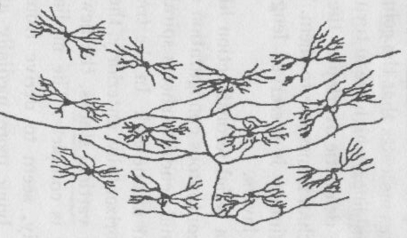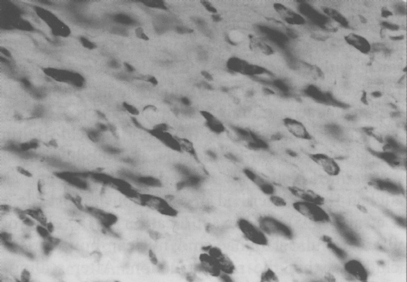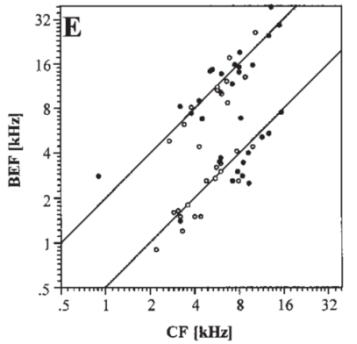The octave - history of a discovery
Martin Braun
Neuroscience of Music, S-671 95 Klässbol, Sweden
Date of publication: March 2010
Before
500 BC
Archeology
The earliest definite evidence of octave circularity in hearing are
the tone name inscriptions on Chinese bronze age bells, which often
survived optically and acoustically fully intact in tombs. Bell ensembles
where the tone range extends beyond one octave have the same tone names
for octave-spaced tones. The largest and best-studied extant ensemble
are the Zeng Bells, where 65 bells ring
in five octaves.

1965
Neuroanatomy
In a large-scale anatomical study of the auditory thalamus (medial
geniculate nucleus of the thalamus) in the cat Kent
Morest found that a large part of it has its main nerve fiber network
organized in stacked layers, so-called laminae (see drawing of 12 neurons
from three laminae with parts of their fiber network).
Based on several counting and measurement techniques Morest estimated that the whole laminated structure consisted of ca 50 layers of nerve cells. Based on the observed nerve fiber connectivity he also suggested that neighboring layers might be combined as layer groups that perform as functional layers.
Morest proposed that this organization probably had a specific function in the processing of acoustic frequencies. His results were replicated in several other mammalian species. For the rabbit Justin Cetas et al. in 2001 even obtained images of the chains of nerve cell bodies that are the core of the fiber laminae (see microphotograph of diagonally oriented cell body chains).


1980
Neurophysiology
After recording neural responses from a very large number of locations throughout the auditory thalamus of the cat Anne Morel presented a statistical tone map of this nucleus. She grouped the map into octave sections and found that these map sections appeared as stacked layers with a spatial orientation that was fully congruent with the spatial orientation of the nerve fiber network that Morest had reported 15 years before. She estimated that one octave layer was ca 400 µm thick. According to Morest's data one octave is thus represented by a cluster of ca 8-10 neural laminae.
In a later study from 1985, now together with Thomas Imig, Morel published data showing that an octave layer only represented one tone frequency (or a narrow frequency band) in its thickness dimension. For example, a continuous recording series transverse to the laminae revealed only data points at 0.5 and 0.6 kHz over a distance of ca 400 µm, then a sudden jump to a stable series of data points near 1.2 kHz, and after that again a jump to a series near 2.4 kHz.
In 2001 these physiological findings were fully replicated and even extended by Cetas et al. for the rabbit, the only difference being that here one octave layer was ca 300 µm thick.
The described architecture represents octave intervals transversally across lamina clusters and a fine-graded tone scaling along the plane of a lamina cluster. In musical terms, the frequency data of the given example would mean that the neural representation of the tones D5, D6, and D7 are placed in series and thus lumped together to a "general D".
In music psychology the general tone quality that reappears at the same position in each octave frame is called "chroma" (or "pitch class"). The auditory thalamus appears to contain a neural chroma map, which would readily explain both the circularity of pitch and the phenomena of implicit and explicit absolute pitch (which actually are memories of chroma).
To use a simplified image, in the "chroma department" of the
brain, pitch representation zigg-zaggs upwards along the planes of stacked
sheets and thus is organized in vertical chroma columns.
2000
Behavior
In an extensive investigation of octave related hearing behavior of the rhesus monkey (macaca mulatta) Anthony Wright et al. consistently recorded "same" responses for melody shifts over one octave and over two octaves, but "different" responses for melody shifts over 0.5 and 1.5 octaves.


2005
Chroma map
When analyzing a large body of data on pitch shift experienced by a musician with absolute pitch under the influence of the neurotropic medical drug carbamazepine, Martin Braun and Vladimir Chaloupka found that the musician had a slightly irregular, but highly characteristic, internal chroma representation. It was similar in all of the six tested octave ranges and remained unaffected by the drug induced pitch shift.
In 2006 Braun further reported that the statistical frequency distribution of spontaneous inner ear tones in humans showed two neighboring octave bands with a similar pattern of distribution density. In musical terms, the two bands extended from C6 to C7 and from C7 to C8. In both cases they had a peak distribution in the region around F-G, Three years later Liu et al. reported the same octave bands with the same chroma pattern from the statistics of 769 spontaneous inner ear tones from 224 ears of newborn babies.

Update
2012
Thalamic octave lamination has strong impact on auditory cortex
In the primary auditory cortex (AI) of the cat, Brosch and Schreiner (2000) found that the response upon two tones, separated by ~ 100 ms, was strongest when their frequency difference was close to one octave. The same effect was also observed in a large fraction of neurons in AI and the caudomedial auditory cortical fields in the macaque monkey (Brosch, Schulz, and Scheich, 1999).
These findings imply a causal relation between anatomical octave spacing
in the thalamus and octave-based spectral filtering at the next and the
following stages of auditory processing. This includes the filtering of
pitch class (chroma) from natural tonal signals, such as in vocalization,
which provides the basis of implicit and explicit absolute pitch (AP)
in humans.

References:
Morest, D.K., 1965. The laminar structure of the medial geniculate body of the cat. J. Anat. 99, 143-160.
Morel, A., 1980. Codage de sons dans le corps génouille médian du chat: évaluation de l'organisation tonotopique de ses différents noyaux. Thèse de l'Université de Lausanne, Faculté des Sciences, Janis Druck und Verlag, Zürich, pp. 1-154.
Imig, T.J., Morel, A., 1985. Tonotopic organization in ventral nucleus of medial geniculate body in the cat. J Neurophysiol 53, 309-340. (Note data series from electrode penetration P1 in their Figs. 6 and 7 showing stepwise frequency representation with discrete clusters around 0.6, 1.2, and 2.4 kHz)
Brosch M., Schulz A., Scheich H., 1999. Processing of sound sequences in macaque auditory cortex: response enhancement. J Neurophysiol 82, 1542–1559.
Brosch M., Schreiner C.E., 2000. Sequence sensitivity of neurons in cat primary auditory cortex. Cereb Cortex 10, 1155–1167.
Wright, A.A. et al., 2000. Music perception and octave generalization in rhesus monkeys. J Exp Psychol Gen 129, 291-307. Abstract and Comment
Cetas, J.S., Velenovsky, D.S., Price, R.O., Sinex, D.G., McMullen, N.T., 2001. Frequency organization and cellular lamination in the medial geniculate body of the rabbit. Hear. Res. 155, 113-123.
Cetas, J.S., Price, R.O., Velenovsky, D.S., Crowe, J.J., Sinex, D.G., McMullen, N.T., 2002. Cell types and response properties of neurons in the ventral division of the medial geniculate body of the rabbit. J. Comp. Neurol. 445, 78-96.
Cetas, J.S., Price, R.O., Crowe, J.J., Velenovsky, D.S., McMullen, N.T., 2003. Dendritic orientation and laminar architecture in the rabbit auditory thalamus. J. Comp. Neurol. 458, 307-317.
Braun, M., Chaloupka, V., 2005. Carbamazepine induced pitch shift and octave space representation. Hear. Res. 210, 85-92. Abstract, ask for PDF
Braun, M., 2006. A retrospective study of the spectral probability of spontaneous otoacoustic emissions: Rise of octave shifted second mode after infancy. Hear. Res. 215, 39-46. Abstract, ask for PDF
Liu J, Wang N, Li J, Shi B, Wang H , 2009. Frequency distribution of synchronized spontaneous otoacoustic emissions showing sex-dependent differences and asymmetry between ears in 2- to 4-day-old neonates. Int J Pediatr Otorhinolaryngol 73, 731-736. Abstract and Comment
Back to: First Page English, NOM Home Page